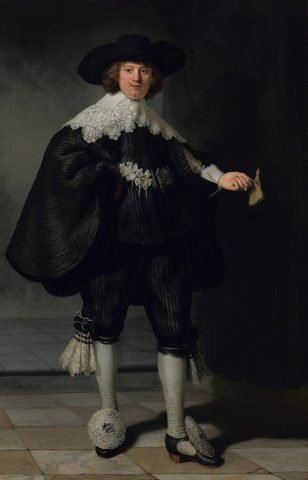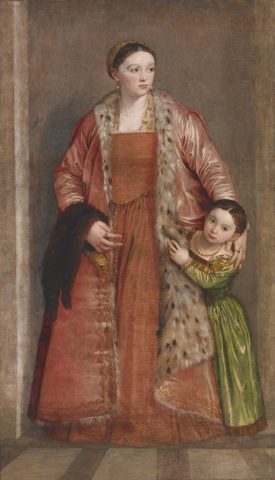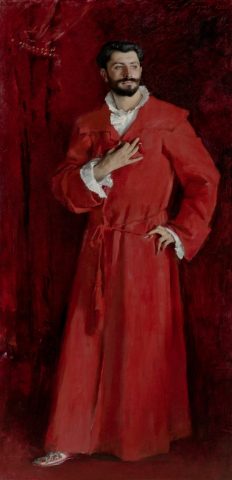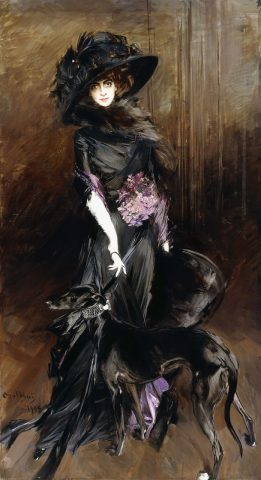More than 160 million reasons to buy half of a Rembrandt
In 2016 the Netherlands and France jointly acquired from the De Rothschild family the only double full length portrait painted by Rembrandt. Now the work is ready for being exhibited. The Rijksmuseum celebrates the event with a show questioning the European high society through full length, life-size portraits.
- Rembrandt van Rijn, Portrait of Marten Soolmans , 1634. Acquired by the Dutch State for the Rijksmuseum.
- Rembrandt van Rijn, Portrait of Oopjen Coppit, 1634. Acquired by the French Republic for the Musée du Louvre.
- Lucas Cranach the Elder, Henry the Pious, Duke of Saxony, 1514. Gemäldegalerie Alte Meister, Staatliche Kunstsammlungen Dresden.
- Lucas Cranach the Elder, Catherine, Countess of Mecklenburg, 1515. Gemäldegalerie Alte Meister, Staatliche Kunstsammlungen Dresden.
- Paolo Veronese, Iseppo do Porto with his son Adrian, c. 1555. Florence, Galleria degli Uffizi, Contini Bonacossi Collection.
- Paolo Veronese, Livia Thiene with her daughter Porzia, c. 1555. The Walters Art Museum, Baltimore, Maryland.
- John Singer Sargent, Dr Pozzi at home, 1881. The Armand Hammer Collection, Gift of the Armand Hammer Foundation. Hammer Museum, Los Angeles.
- Giovanni Boldini, Marchesa Luisa Casati with a Greyhound, 1908. Private collection.
- Taco Dibbits, ph. Stefano Pirovano.
After spending more than four centuries in private hands, and after ten months in the skillful hands of the restorers, the two full length portraits of the spouses Marten Soolmans and Opjen Coppit painted by Rembrandt in 1634 are, since last week, available to the public. France and the Netherlands have jointly bought the two paintings in 2016 from the De Rothschild family for slightly more than €160 million, thus establishing the first jointly ownership of this kind in the history of art. ‘A group of Dutch philanthropists were also willing to purchase the entire work’ explained Taco Dibittis, the Rijksmuseum’s general director. However, France didn’t want the work to leave the country where it had been since Éric de Rothschild wanted the Dutch spouses as an ornament for his own bedroom. So came the decision of a jointly ownership, thus maintaining the two portraits together. Technically, according to what Mr Dibbits asserts, Louvre owns Opjen, while Marten belongs to the Rijksmusem. Nevertheless the agreement establishes that the two portraits are inseparable, hence the two countries have agreed on exhibiting them alternatively. The Netherlands will be the first to display them, for three months. Then the works will go back to Paris (Louvre, from September 2018) for another three months. Since that moment there will be 5 and eight year-cycles.
Seen in person, the two works are really impressive, and we have the feeling that France and the Netherlands have done a great job and managed to convey an extremely positive message in a time of large inequalities and arousing private powers. It has to be regarded as a positive fact that the two governments were brave enough and found the resources to penetrate the market of private players to keep in Europe, and at the disposal of its citizens, such an important piece of our history. Art doesn’t represent the ultimate solution to everyday issues – job, economics, healthcare. Yet it is necessary to start from culture, thus art, to properly tackle these problems. After all, artworks are the opposite of indirect taxation. Everyone benefits to the same extent.
The restoraton of the Soolmans newlyweds was carried out by the Rijksmusem and the Centre de Recherche et de Restauration des Musées de France. The paintings had been previously restored at different moments and in different places at the beginning of the 1950s – Marten in New York, in 1952; Oojen in Amsterdam, four years later. The first step was removing the top layers of modern varnish and thinning down the old restoration layers to return the colours their original dynamism. ‘Black fabrics were the most precious at that time’ explains Mr. Dibbts, as they were the most difficult to dye and preserve. Rembrandt painted them with extreme care, and very accurate lines. The white laces had been obtained by using black paint on a uniform white background. We would also point out the roses embellishing Mr. Soolmans’ shoes. After the restoration, they seem to have taken on a sparkling flashiness. These are however only the most visible results of the past-months restoration work. As a matter of fact, analysis disclosed at least two important discoveries. First of all, Rembrandt used the same wide piece of fabric, which he then cut into two canvases after he had painted the preparatory layer. This may imply that the painter had actually considered the idea of executing the double portrait on the same piece of fabric. Secondly, Macro-XRF scanning also revealed that originally Rembrandt had painted an arch behind Marten Soolmans (later covered up with curtains) and two more arches behind his wife. The space would thus be deeper and airier, more coherent with the floor and the step painted by Rembrandt in the background.
Even if it were just a correction of the original idea, possibly made by the artist as instructed by his client, the result is by no means questionable. And his peers must have thought likewise, given that Opjen Coppit’s second husband, Capitain Maerten Daey, decided to keep the painting that essentially celebrated the previous marriage of his wife. That is to say, you can’t rule a Rembrandt.
Considering that it is the portrait of two young newlyweds (she is pregnant), the Rijksmusem had the brilliant idea of organizing a party, where it invited the most illustrious representatives of the same high society Soolmans had been part of. Thus it came the idea of planning an exhibition dedicated to full length, life-size portraits, also unique in its genre. To this unmissable social event there are characters like Henry the Pious and his wife (Lucas Cranach, 1514-1515), Charles V with his English Water Dog (Jackob Seisnegger, 1532), Livia Thiene and Iseppo da Porto with children (Paolo Veronese, 1555), Bernardo Spini and Pace Rivola Spini (Giovanni Battista Moroni, 1573-75), but also personalities closer to our time like Marcellin Gilbert Desboutin (Edouard Manet, 1874), the Marchesa Luisa Casati (Boldini, 1908), or Dr. Samuel-Jean Pozzi (John Singer Sargent, 1881). These portraits are often sumptuous, with many references to the subject of the painting, and the culture of the epoch he/she was living in, certainly more expressive than the half-length portraits, where the background is sometimes given up in favour of the intimacy of the gaze. Titled High Society, the exhibition is the best homage that could be paid to Rembrandt’s double portrait and to the European culture and its infinite histories.
November 25, 2020









